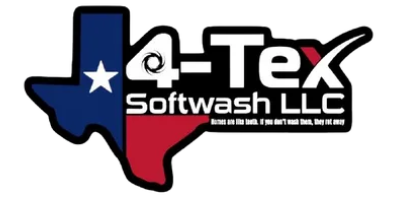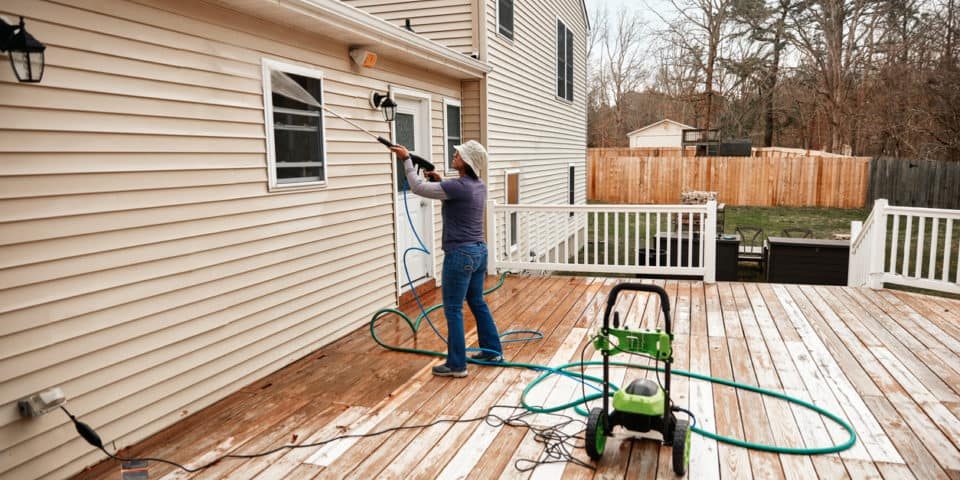House pressure washing is an effective way to rejuvenate the exterior of your home, boosting curb appeal and maintaining the integrity of your property. This guide will explore everything from the basics of pressure washing to advanced techniques, ensuring your home looks its best.
The Basics of Pressure Washing
Different Types of Pressure Washers
When it comes to house pressure washing, choosing the right equipment is crucial. Pressure washers come in two main types: electric and gas-powered. Each has its advantages in terms of power (PSI – pounds per square inch) and water flow (GPM – gallons per minute).
Safety First: Using a Pressure Washer
Safety is paramount in house pressure washing. Always wear protective gear, including goggles and gloves. Understand your pressure washer’s operation to avoid damaging your home’s exterior or causing injury.
Preparation Steps
Before you start house pressure washing, prepare the area. Clear it off movable objects, protect delicate surfaces like windows, and consider pre-treating the surface with appropriate detergents for more effective cleaning.
When to Pressure Wash Your House
Best Times of Year for Pressure Washing
The best time for house pressure washing is typically during spring or fall. These seasons offer moderate temperatures and are ideal for cleaning and preparing your home’s exterior for extreme weather.
Signs Your House Needs Pressure Washing
Look for signs like dirt accumulation, mold growth, or the aftermath of storms. These indicators suggest it’s time for a house pressure washing session to restore your home’s beauty.
Frequency of Pressure Washing
Typically, house pressure washing is recommended annually. However, factors like local climate and your home’s exposure to elements might necessitate more frequent washes.
DIY vs. Professional Pressure Washing
Pros and Cons of DIY Pressure Washing
DIY house pressure washing can save money but requires time, effort, and a degree of skill. Safety risks and potential for damage also increase without proper experience.
Hiring Professional Pressure Washing Services
Professional house pressure washing services offer expertise and efficiency but at a higher cost. When dealing with complex or large-scale projects, their services can be invaluable.
Combining DIY and Professional Services
For some, a combination approach works best. Tackle smaller, manageable tasks yourself, and leave the more challenging aspects of house pressure washing to professionals.
Tips for Effective Pressure Washing
Techniques for Different Surfaces
Different surfaces, be it siding, decks, or driveways, require unique house pressure washing techniques. Adjust your approach based on the material to avoid damage.
Adjusting Pressure Settings
Understanding how to adjust pressure settings is crucial in house pressure washing. Too much pressure can damage surfaces, while too little might not be effective.
Detergents and Cleaning Solutions
Select appropriate detergents for house pressure washing. Consider eco-friendly and pet-safe options, applying them correctly for the best results.
Addressing Common Challenges
Dealing with Stubborn Stains
When house pressure washing, you may encounter stubborn stains like oil or rust. Pre-treat these areas with specialized cleaners and use a higher pressure setting carefully to remove them without damaging the surface.
Managing Mold and Mildew
Mold and mildew are common foes in house pressure washing. Use a mixture of water and mildewcide or a bleach solution to treat affected areas before washing, ensuring a thorough cleanse.
Working Around Landscaping and Delicate Areas
While house pressure washing, it’s crucial to protect your landscaping. Cover plants and flowers to shield them from high-pressure water and chemicals, and use lower-pressure settings near delicate features.
The Environmental Impact of Pressure Washing
Water Usage and Conservation
Efficient water usage is a key consideration in house pressure washing. Opt for pressure washers that are water-efficient and avoid washing during drought conditions to conserve water.
Choosing Environmentally Friendly Cleaners
Select biodegradable and non-toxic cleaners for house pressure washing. These products protect the environment while effectively cleaning your home’s exterior.
Reducing Runoff and Protecting Wildlife
Be mindful of water runoff when house pressure washing. Contain and properly dispose of soapy water to prevent it from entering storm drains, protecting local wildlife and water sources.
Advanced Pressure Washing Techniques
Hot Water Pressure Washing
For tough grime, hot water house pressure washing can be more effective. This method is great for removing oil or grease stains but requires specialized equipment.
Pressure Washing with Attachments
Using attachments, such as surface cleaners or specialized nozzles, can enhance your house pressure-washing experience. They provide targeted cleaning and can help tackle specific tasks more efficiently.
Soft Washing: An Alternative Approach
Soft washing is a lower-pressure method of house pressure washing, ideal for delicate surfaces. It involves using detergents and a softer water stream to gently clean without causing damage.
Maintaining Your Pressure Washer
Routine Care and Upkeep
Proper maintenance of your pressure washer ensures its longevity and effectiveness. Regular cleaning, proper storage, and routine checks are essential parts of house pressure washing equipment care.
Troubleshooting Common Issues
Familiarize yourself with common issues like loss of pressure or leaks. Understanding basic troubleshooting can save time and frustration during your house pressure washing tasks.
Winterizing and Long-Term Storage
If you live in a region with harsh winters, winterizing your pressure washer is a crucial step. Drain all water, add antifreeze if necessary, and store it in a frost-free environment to prevent damage.
The Aesthetics and Value of Pressure Washing
Enhancing Curb Appeal
House pressure washing significantly enhances your home’s curb appeal. A clean, well-maintained exterior is inviting and can make a remarkable difference in your home’s overall appearance.
Increasing Property Value
Regular house pressure washing not only maintains but can also increase your property’s value. A clean exterior is more attractive to potential buyers and can contribute to a higher resale value.
Health and Safety Benefits
Removing allergens, pollutants, and slippery moss or algae through house pressure washing contributes to a safer and healthier living environment, reducing potential health hazards.
Legal and Neighborhood Considerations
Noise Ordinances and Regulations
Be aware of local noise ordinances when planning your house pressure washing. It’s best to operate during daytime hours and inform your neighbors in advance to maintain good relations and compliance.
Water Usage Restrictions
In areas with water restrictions, it’s important to adhere to local laws regarding house pressure washing. Consider water-efficient models or explore alternative cleaning methods during drought conditions.
Respecting Privacy and Property Lines
House pressure washing requires mindfulness of overspray, especially near property lines. Respect your neighbors’ privacy, avoid damaging shared fences or walls, and ensure your cleaning doesn’t impact their property.
Cost-Effective Pressure Washing
Budgeting for Pressure Washing
When budgeting for house pressure washing, consider both immediate and long-term costs. DIY can be more affordable but weighs the potential for higher costs due to mistakes or inefficient cleaning.
Renting vs. Owning a Pressure Washer
Deciding whether to rent or buy a pressure washer depends on your frequency of use and storage capacity. Renting is a good option for infrequent use while buying could be more cost-effective for regular house pressure washing.
Maximizing Efficiency to Reduce Costs
Plan your cleaning route efficiently to save time and resources. Focus on conserving water and detergent and prioritize areas that need the most attention to make your house pressure washing both effective and economical.
Future Trends in Pressure Washing
Technological Advancements
The future of house pressure washing sees technological advancements like more efficient water usage, smarter machines with automated features, and enhanced cleaning capabilities.
Emerging Cleaning Solutions and Techniques
Innovative, eco-friendly cleaning solutions are becoming more popular in house pressure washing. Advanced techniques that offer thorough cleaning with minimal environmental impact are on the rise.
The Evolving Role of Pressure Washing in Home Care
House pressure washing is increasingly recognized as a vital part of home maintenance. It’s evolving from a luxury or occasional task to a standard practice in home care routines.
Frequently Asked Questions (FAQs)
What is the Best Time of Year to Pressure Wash My House?
The ideal times are during the spring and fall. These seasons provide moderate temperatures and are perfect for preparing your house’s exterior for the harsher weather of summer and winter.
Can Pressure Washing Damage My Home’s Exterior?
If not done correctly, pressure washing can cause damage. It’s important to use the right pressure settings and techniques, especially for sensitive materials like wood or stucco.
How Often Should I Pressure Wash My House?
Generally, it’s recommended to pressure wash your house once a year. However, this can vary depending on your local climate and the amount of exposure your home has to dirt, debris, and other pollutants.
Should I Hire a Professional or Can I Do It Myself?
This depends on your comfort level and experience with pressure-washing equipment. For complex or large homes, it’s often safer and more effective to hire a professional.
What Should I Do to Prepare My House for Pressure Washing?
Clear the area around your house of any furniture, toys, or other items. Close all windows and doors, and cover any delicate plants or decorations.
Is Pressure Washing Safe for All Types of Siding?
Most siding types can handle pressure washing, but it’s crucial to use the correct pressure settings. Soft materials like wood or certain types of vinyl may require a softer wash or lower pressure.
Can Pressure Washing Remove Mold and Mildew?
Yes, pressure washing can be effective in removing mold and mildew. However, it may be necessary to use specific cleaning solutions to completely eradicate these growths.
How Much Does Professional House Pressure Washing Cost?
The cost varies depending on the size of your home and the complexity of the job. On average, it can range from a few hundred to over a thousand dollars.
What are the Environmental Considerations of Pressure Washing?
Consider the impact of water usage and the chemicals in cleaning solutions. Using eco-friendly and biodegradable cleaners and being mindful of water runoff is important.
Can I Pressure Wash Windows and Gutters?
Windows and gutters can be pressure washed, but it requires a gentle touch with lower pressure settings to avoid damage.
What is the Difference Between Power Washing and Pressure Washing?
Power washing uses hot water to clean surfaces, which can be more effective for certain types of stains and grime. Pressure washing typically refers to using cold water.
How Long Does It Take to Pressure Wash a House?
The time it takes can vary widely based on the size of your house and the specific areas being cleaned. A typical home might take a few hours to a full day.
Conclusion
Regular house pressure washing is an invaluable practice for maintaining and enhancing your home’s appearance and value. By following the guidelines and tips outlined in this article, you can ensure your home not only looks its best but also remains a healthy and safe environment for your family. Whether you choose to DIY or hire professionals, remember that the cleanliness and upkeep of your home’s exterior is a reflection of the care you put into it.







